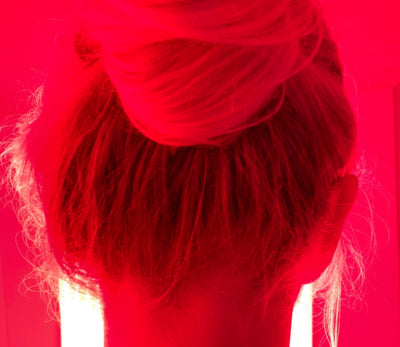
Red Light Therapy - Best Value LED Devices for Home Use
Share
If you thought that Instagram had been invaded by a colony of Stormtroopers, perhaps you are not yet familiar with Red Light Therapy masks?
Touted as a panacea for anti-aging, acne treatment, pain management and wound healing, it seems LED light therapy, also known as photo biomodulation, has something to offer everyone. For us skincare fanatics, with the premise of a more even, brighter skin tone, reduced wrinkles, and fewer acne breakouts, who wouldn’t want to glow up with red, blue or green LED light?
Celebrity Makeup artist Wayne Goss spoke about the Current Body LED Mask on his You Tube channel in October 2019, and kicked up quite a storm! But celebrities the world over, from Jessica Alba to Courtney Kardashian are taking to LED therapy and for good reason, it works!

Green Tea and LED Light Therapy
Most anti-aging therapies like chemical peels, micro derma abrasion and micro-needling are abrasive and work by causing micro injuries to the skin, which stimulate cellular repair mechanisms to boost collagen production. Red light therapy, on the other hand, is non-invasive. Its skin rejuvenation effects work from the inside out, stimulating cells to increase their cellular energy, which drives all cellular processes and can help increase collagen levels.
So, if you don’t know watt the hype is all about (did you see what I did there?), let’s shed some light on the matter (sorry, couldn’t resist that one!).
What is LED Light Therapy?
LED light therapy has been around for more than 30 years and was originally developed by NASA to help astronauts prevent muscle atrophy and aid tissue healing. But with such wide-ranging benefits for skin health, it is perhaps not surprising that it has found a home in the beauty industry.
As we age, our skin loses collagen and becomes less ‘elastic’. This, together with other physiological changes and environmental damage, leads to skin sagging, fine lines and wrinkles and an uneven skin tone. LED light therapy targets skin cells to help reverse the signs of ageing by stimulating collagen and elastin, alleviating redness and reducing the appearance of fine lines and wrinkles.
Within the beauty industry, Aestheticians were among the first to offer LED light therapy, with treatments costing as much as £150 a session. But in more recent years, home treatment devices for LED therapy have become more common.

How does it work?
Whilst there are many mechanisms cited for how LED light therapy works, one common theme is that LED light stimulates cells to produce more energy, which drives cellular processes. This may sound far fetched at first but when you consider that plants use light energy to convert carbon dioxide to oxygen through a process called photosynthesis, why should animal cells be so different? The evidence suggests that we can use light energy too.
In animal cells, cellular energy is dependent on ATP, or Adenosine Triphosphate, an organic compound found in every cell of our body. ATP drives all living processes from muscle contraction, nerve impulses to protein synthesis, which includes collagen. Collagen renewal is integral to maintaining a healthy skin structure and a more youthful appearance.
LED light therapy targets cells in the extra cellular matrix (ECM) and can undo damage which has been done to these cells. ATP produced from LED light provides the energy that our skin cells need to repair themselves from free radical damage caused by exposure to environmental stressors like UV light and pollution. But use of Red Light Therapy produces free radicals as a by-product. Small amounts of free radicals, or Reactive Oxygen Species (ROS), however have been found to stimulate cell activity and is believed to be a key element of the mechanism of photo biomodulation.
Red, Green or Blue Light – which do I need?
As LED masks are so Instagram friendly, you may have seen an array of colours for LED therapy, from red and green to blue. So, what do the different colours do?
Red Light is the most popular form of LED light therapy and is used for anti-aging, treating muscle pain and various other ailments.
Green LED light is aimed at treating hyper-pigmentation.
Blue LED light is generally marketed for treating acne, although red LED light will do this just as well.

Red and Near Infra-Red – what is the difference?
Red light is the preferred colour for LED light therapy but many LED light therapy devices offer red light, near infra-red light or a combination of the two. So, which one is better for skin rejuvenation or do you need both?
Red Light is within the visible light spectrum between 610 to 700 nm, with much data to support that 660-670 nm is an optimum wavelength. This wavelength is ideal to penetrate skin cells and sebaceous glands and offer benefits for skin rejuvenation, including improvements to skin tone, texture and smoothing fine lines and wrinkles. Red wavelengths of light are absorbed and used in the first 25mm of skin tissue.
Near – infrared (NIR), is not within the visible light spectrum between wavelengths of 700-1100 nm, with 830-850 nm being one of the most efficiently absorbed wavelengths. This light penetrates deeper into tissue and so is good for targeting deeper tissue layers. NIR can help increase blood circulation as well as treat muscle aches, nerve injury and joint pain.
If your only goal is to treat the surface of your skin to improve skin texture and tone and boost collagen deposition, then red LED light would be effective for this purpose, but the addition of infra-red light to stimulate blood flow to the upper layers of the skin can only be advantageous.
When should you use Red Light Therapy?
The frequency and duration of use will depend largely on the device that you choose. But either way, you do not need to invest much time on a daily basis to reap the benefits of Red Light Therapy. If you choose a panel or a bulb with the recommended power output, then just five minutes per day will provide a cumulative treatment that will aid skin rejuvenation. If using a mask, the recommended session time is usually around 15 minutes but the time to see a benefit will be considerably longer.
As little time commitment is required, you may find that you can easily incorporate this into your AM or PM skincare routine. And hey, if you are Trinny Woodall, who is to blink an eye lid if you jump in a taxi with your LED mask on?
As LED light therapy can help heal wounds, one popular application is to use it post micro-needling, to help heal those micro-injuries even faster. Whether you use LED light therapy in combination with other skincare treatments or in isolation, the benefits for skin rejuvenation are bountiful.

What should you be looking for from an LED device?
With so many devices on the market from LED masks, bulbs and panels, where do you start? Whilst LED masks are fun and offer the benefit of multitasking opportunities to sit in front of the television or do your ironing, you should be aware that the irradiance (the power emitted by the LED lights) is significantly less than that achievable from a bulb or a panel. This means that you would need to increase the duration and frequency of your sessions relative to other devices. Most masks, like LED mask brand Aduro, emit around 3mw/cm2.
That aside, according to expert Ari Whitten, best-selling author of The Energy Blueprint, the optimum power output that you should be looking for from your red (or other colour) light therapy is in excess of 100mw/cm2 from the distance at which you will use your light. For example, many devices will report the irradiance at source and at a distance, usually of about 6 inches (15 cm). As you are likely to sit slightly away from your panel or bulb, then the latter is the measurement that you should note.
Which LED Device should I purchase?
Pulse40 LED Light Therapy Panel
Specification: Red (660nm) + near infrared (850nm) wavelengths. 40 x 5W LEDS
Maysama’s Pulse40 LED Light Therapy Panel incorporates science-backed LED wavelengths, red [660nm] and near infrared [850nm], together with pulsed light, our progressive technology helps optimise the beneficial effects of photobiostimulation, whilst mitigating ROS-induced oxidative stress.
Specification: 4 wavelengths: red (630 + 660nm), near infrared (850nm) and blue (450nm)
As well as three light modes, Maysama PRANA LED Light Therapy Mask uses super-pulsed light technology to help 'breathe' skincare ingredients into your skin, to increase the bioavailability of active ingredients and increase the efficacy of your skincare. Unlike other masks on the market, it covers the mouth area ensuring the lips are treated.
Before creating these products, I did my research, comparing irradiance and price of various LED light therapy devices for home use. There were two devices that stood out to me.

Firstly, this Red and NIR LED Light Therapy Lamp from Amazon offers an illuminance of 98mw/cm2 at a 6 inches and retails at just £38.99! This is the one I have purchased for myself. It combines red 660nm with Infrared 850nm LEDs. I think this is a fantastic starting point for anyone wishing to try out Red Light Therapy and decide if it is for you. I also purchased this elegant yet sturdy Tomons Wood Swing Arm Desk Lamp stand, which gives a versatile set-up, ideal for any home.

Secondly, I am super-impressed with this cute Red Infrared Combo Light from Red Light Man, UK. Offering double the power output at 200mw/cm2 at 15cm, this high-power cube lamp is on my wish list. The current sale price is just £240, so relative to any LED mask, which offers a fraction of this dose, this is a really good deal. I just need to save a few more pennies!
For the sake of completeness, here are some of the other brands and devices that I looked at. All of these offer a power output close to, or in excess of, 100mw/cm2.
Platinum LED
https://platinumtherapylights.com/collections/shop
Various devices of 660nm + 850nm with power output of 112mw/cm2 at 12 inches.
Prices range from $369 to $2198
Mitored
Red 620nm – 700nm and NIR 800-880nm Power 300w to 1500w
Prices range from $249 to 1049
Hooga HG300
https://www.amazon.com/Infrared-Irradiance-Anti-Aging-Performance-Optimization/dp/B07T81R1DX
660nm & 850nm
Irradiance: 80mw/cm2 at 6 inches
Price: $189.99
Red Rush360
https://redtherapy.co/products/redrush-360-light
660 + 850nm
Irradiance: 100.5mw/cm2 at 6 inches
Price Redrush 720 Ulta Body Light $799
Sgrow
https://www.amazon.com/SGROW-Light-Infrared-Therapy-Relief/dp/B07JW9RZ7K
660 & 850nm
Irradiance > 100mW/cm2 (doesn’t state at what distance, so could be at source)
Price: $39.99
Bestqool
Full-Body Red Light Therapy Y-200
660 + 850nm
Irradiance: >94mw/cm2 at 6 inches
Half Body £235.99
Full body: 200 LED’s £472.99

I am no expert in Red Light Therapy but, with a background in science, I am convinced of its benefits for skin rejuvenation. The combination of green tea antioxidants can speed up the effects of Red Light Therapy and I am excited that MAYSAMA Green Rooibos Pressed Serum has found a niche in this growing market. High doses of LED light can lead to excess free radicals which can lead to cell damage, so it is important to control ROS levels.
As I discussed in my blog, Green Tea or not Green Tea – that is the Question!, green tea and green rooibos tea have a high polyphenolic content and
correspondingly high antioxidant capacity. Both green tea and green rooibos tea are excellent free radical scavengers, proven to undo cell damage caused by free radicals and to increase cell survival rate.
If you would like to learn more about my journey with LED therapy in combination with MAYSAMA Green Rooibos Pressed Serum, please subscribe to my mailing list for updates. And if you would like to learn more about the science behind MAYSAMA skincare brand please do check out my website!
Best wishes
Bev xx






